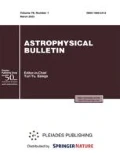Abstract
Our spectrophotometric analysis of the atmospheres of HD 37058, HD 212454, and HD 224926 shows these objects to be typical He-w stars with close-to-zero microturbulence velocities, very different magnetic fields, and wide scatter of chemical anomalies. However, one of the main manifestations of separation is that helium moves from the outer layers of the atmosphere into the star’s interior.
Our analysis of the stars HD 212454 and 224926 with Be<100 G shows that despite their weak magnetic fields they have the same degree of chemical anomaly as highly magnetized stars. Chemical composition varies over a wide range for stars with the same magnitude of magnetic field. We find the conditions in the temperature interval 13000–16000 K to be the most favorable for the formation of He-w type stars. Helium underabundance is the strongest near the maximum of the distribution and it is observed in stars with weak as well as strong fields. Because of the scatter mentioned above the degree of chemical anomalies is not strictly related to the magnitude of the magnetic field, although the field has an appreciable effect on the formation of chemical inhomogeneities at the star’s surface. Its influence is minimal in stars with very weak magnetic fields and the presence of strong chemical anomalies indicates that microturbulence in these stars is sufficiently weak even without the effect of the magnetic field. It is plausible to assume that the anomalies arise due to slow rotation.
The temperature dependences of rotation velocity vsini for stars with weak magnetic fields show no apparent trends associated with the magnitude of magnetic field. The rotation velocities vsini of almost all stars are lower than those of normal stars, except for HD 131120, 142096, 142990, and 143669, which rotate with the same velocity or even faster than normal stars. These objects do not obey the general rule and their example shows that stable atmospheres can also be found among fast rotators and that magnetic field takes no part in the spin-down of CP stars. We believe that CP stars inherited their slow rotation from protostellar clouds.
Similar content being viewed by others
References
Yu. V. Glagolevskij, V. V. Leushin, G. A. Chountonov, et al. in Magnitnye Zvezdy (Magnetic Stars), eds. Glagolevskij Yu. V., Kudryavtsev D. O., Romanyuk I. I. (Special Astrophysical Observatory of the Russian Academy of Sciences, 2004), p.198.
Yu. V. Glagolevskij, V. V. Leushin, G. A. Chountonov, and D. Shulyak, Pis’ma Astron. Zh. 31, 54 (2005).
Yu. V. Glagolevskij, I. Kh. Iliev, I. K. Stateva, and G. A. Chountonov, Astrofizika 49, 585 (2006).
E. F. Borra, J. D. Landstreet, and I. Thompson, Astrophys. J. Suppl. Ser. 53, 151 (1983).
W. L. W. Sargent, A. I. Sargent, and P. A. Strittmatter, Astrophys. J. 147, 1185 (1967).
P. S. Conti, Astrophys. J. 160, 1077 (1970).
G. Mathys and S. Hubrig, Astron. and Astrophys. Suppl. Ser. 124, 475 (1997).
Yu. V. Glagolevskij, I. I. Romanyuk, N. M. Chunakova, and V. G. Shtol, Astrofiz. Issled. 23, 37 (1986).
Yu. V. Glagolevskij and G. A. Chountonov, Astrofizika 45, 499 (2002).
K. Preston and K. Stepien, Astrophys.J. 154, 971 (1968).
G. A. Chountonov and E. I. Perepelitsin, in Magnetic Fields of Chemically Peculiar and Related Stars, Ed. by Yu. V. Glagolevskij, I. I. Romanyuk (Special Astrophysical Observatory RAS, 2000), p.255.
D. O. Kudryavtsev, in Magnetic Fields of Chemically Peculiar and Related Stars, Ed. by Yu. V. Glagolevskij, I. I. Romanyuk (Special Astrophysical Observatory RAS, 2000), p.84
G. A. Galazutdinov, ftp.sao.ru, (2002).
D. Shulyak, V. Tsymbal, T. A. Ryabchikova, et al. Astron. and Astrophys. 428, 993 (2004).
A. Uesugi and I. Fukuda, Revised Catalogue of Stellar Rotational Velocities (Kyoto Univ. Press, 1982).
H. A. Abt, H. Levato and M. Grosso, Astrophys. J. 573, 359 (2002).
W. D. Heacox, Astrohys. J. Suppl. Ser. 41, 675 (1979).
H. C. Sievers, PASP 81, 33, (1969).
D. A. Klinglesmith, Astrophys. J. 171, 79 (1972).
F. Kupka, N. E. Piskunov, T. A. Ryabchikova, et al. Astron. Astrophys. Suppl. Ser. 138, 119 (1999).
V. V. Leushin and G. P. Topil’skaya, Astrofizika 22, 121 (1985).
Ch. Moore, Multiplet Table of Astrophysical Interest (Princeton, 1945).
A. A. Radtsig and B. M. Smirnov, Parametry Atomov i Atomnykh Ionov (Parameters of Atoms and Atomic Ions (Energoatomizdat, 1986).
J. M. Beckers, A Table of Zeeman Multiplets, (Physical Sciences Research Papers, No. 371, 1969).
H. R. Griem, Plasma Spectroscopy (McGraw-Hill, New York. 1964).
H. R. Griem, Spectral Line Broadening by Plasmas (Academic Press, New York. 1974).
V. S. Dimitrievic, Phys. Rev. 31, 316 (1985).
V. S. Dimitrievic, Astron. and Astrophys. 163, 297 (1986).
V. S. Dimitrievic, Astron. and Astrophys. Suppl. Ser. 82, 519 (1990).
M. Asplund, N. Grevesse, and A.J. Sauval, Cosmic Abundances as Records of Stellar Evolution and Nucleosynthesis, ASP Conference Series, Ed. by F.N. Bash and T.G. Barnes. 30, p.1 (2005).
Yu. V. Glagolevskij, Astron. Zh. 71, 858 (1994).
F. Leone and A. C. Lanzafame, Astron. and Astrophys. 320, 893 (1997).
V. D. Bychkov, L. V. Bychkova, and J. Madej, Astron. Astrophys. 407, 631 (2003).
Yu. V. Glagolevskij and F. G. Kopylova, in Hot CP and magnetic stars, Ed. G. Scholz (Academy of Sciences of GDR, 1990), p.82.
Yu. V. Glagolevskij, Bull. Spec. Astrophys. Obs. 53, 33, (2002).
I. K. Stateva, Astorphys. Sp. Sci. 226, 329 (1995).
Yu. V. Glagolevskij, Astrofizika 46, 339, (2003).
T. A. Ryabchikova, Pis’ma Astron. Zh. 31, 437 (2005).
Z. Lopes-Garsiya, S. J. Adelman, and O. I. ’pintado, Astron. and Astrophys. 367, 859 (2001).
Author information
Authors and Affiliations
Additional information
Original Russian Text © Yu.V. Glagolevskij, V.V. Leushin, G.A. Chountonov, 2007, published in Astrofizicheskij Byulleten, 2007, Vol. 62, No. 4, pp. 338–349.
Rights and permissions
About this article
Cite this article
Glagolevskij, Y.V., Leushin, V.V. & Chountonov, G.A. Chemical composition of the He-w stars HD 37058, 212454, and 224926. Astrophys. Bull. 62, 319–330 (2007). https://doi.org/10.1134/S1990341307040037
Received:
Accepted:
Issue Date:
DOI: https://doi.org/10.1134/S1990341307040037


